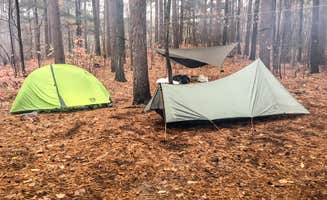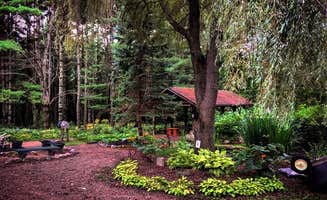The Chequamegon National Forest around Bruce, Wisconsin features diverse primitive camping options. Located within the northern hardwood forest ecosystem at elevations between 1,200-1,500 feet, the region experiences cold winters and mild summers with average July temperatures around 70°F. Tent camping sites span from basic backcountry locations to developed campgrounds with varying amenity levels, most operating seasonally from late spring through early fall.
What to do
Water activities on no-wake lakes: North Twin Lake Recreation Area offers excellent fishing for bass, bluegill, and perch in a peaceful setting. "The campground was always very peaceful and all the campsites on the lake had plenty of space for multiple tents or campers," notes a regular visitor. "It's a no wake lake so plan on just using a trolling motor or even a canoe to fish."
River paddling routes: Campers at Phipps Landing can access the Namekagon River directly. "You can drive in and park at this site, or canoe down the Namekagen and pull up," explains one reviewer. The landing serves as both a campsite and river access point with three established tent sites.
Hiking the Ice Age Trail: The region features multiple access points to this historic 1,200-mile trail, which showcases geological features formed by continental glaciation. The trail connects several camping areas, including primitive sites that serve as perfect basepoints for multi-day hiking trips.
What campers like
Private waterfront access: Picnic Point Campground offers tent-only sites with water views. "Very nice lake, nice and private," reports one camper. Another mentions it's an "Amazing group tent site on Mondeaux" with boat landing access to the Ice Age National Scenic Trail.
Natural tent pads: Backcountry sites often feature hemlock or pine groves that provide natural protection and comfortable ground. Many primitive sites have natural forest floor padding that works well for tent setup when properly prepared.
Free dispersed camping: Several primitive sites in the Chequamegon National Forest have no fees, allowing budget-conscious campers to enjoy extended stays. Sites generally operate on a first-come, first-served basis, which provides flexibility for spontaneous camping trips.
What you should know
Limited amenities at primitive sites: Most backcountry locations lack modern facilities. At Sailor Creek Campsite, "The site is a bit rough for tents. Lots of roots and low dips make for uncomfortable, possibly damp sleeping. Hammock camping, however, is readily available."
Water sources require treatment: Bring filtration equipment for sites near creeks and lakes. Established campgrounds may provide potable water, but primitive sites require self-sufficiency.
Shoulder season considerations: Fall camping offers fewer crowds but coincides with hunting seasons. Spring camping may involve muddy conditions and higher insect populations.
Campfire regulations: Fire restrictions vary by location and season. Some sites have established fire rings while others require portable fire pans. Always check current fire restrictions before your trip, especially during dry summer periods.
Tips for camping with families
Choose sites with toilet access: While primitive, K and C Country Air Campground provides basic amenities suitable for families. One visitor notes it's a "great place water sewer electric sites. Very quiet campground."
Consider lake proximity: Lakeside sites provide natural entertainment for children, though supervision is required. Sites adjacent to smaller lakes typically have less boat traffic, creating safer swimming environments.
Plan for weather variability: Northern Wisconsin weather can change quickly, even in summer months. Pack additional layers and rain gear for all family members, as temperatures can drop significantly at night.
Pack for insects: The region has significant mosquito populations from late spring through early fall. Bring appropriate repellents and consider screened shelters for meal preparation and gathering areas.
Tips from RVers
Limited RV access to primitive sites: Most backcountry camping areas in the Chequamegon Forest accommodate tent camping only. For RV options, consider established campgrounds with appropriate facilities.
Road conditions for access: Forest service roads leading to many primitive sites can be rough, narrow, or impassable after heavy rain. Scout routes before attempting access with larger vehicles or trailers.
Seasonal availability: Most RV-suitable campgrounds operate from May through mid-October. "From May 1 to mid October" is the standard season for developed campgrounds in the region like Hayward Landing, which offers both tent and limited vehicle camping.




